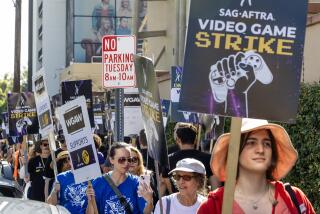SAG’s New Regime to Face 1st Test in Talks Over Pay for Commercials
- Share via
Just four months ago, Screen Actors Guild dissidents toppled the union’s incumbents in an upset election by calling them “pussycats” and promising to be tougher negotiators.
So much for the easy part.
Starting next week, bargainers representing 130,000 members nationwide finally get to put their bluster to the test when talks start with ad agencies over how much actors get paid for commercials.
Though they affect just a small part of Hollywood’s overall production machine, the negotiations will be closely watched because they mark the first bargaining test for the union’s new regime, led by veteran TV actor William Daniels.
Daniels, best known for his Emmy-winning role as Dr. Mark Craig on “St. Elsewhere” and more recently for a role on “Boy Meets World,” was swept into office vowing to take a harder line in contract talks, foreshadowing rockier relations ahead between actors and Hollywood.
Actors are pushing for a 20% raise in residuals--the payments they receive when a commercial runs--for broadcast network ads. But the bigger issue involves increases in pay for spots that run on cable TV, in foreign markets and on Spanish-language television, burgeoning areas where actors feel they are being shortchanged.
The ad industry wants to cut its costs by trimming overtime and extra money paid when commercials are shot on weekends.
During his campaign last fall, Daniels said actors “need somebody who will go to the wall for them. There’s nobody in this town who frightens me.”
The tough talk worked, with the slate led by Daniels ousting the incumbent group led by former SAG President Richard Masur in what was considered a major upset.
*
But Hollywood labor experts warn that tough election talk is risky because it can easily backfire if negotiators can’t deliver a contract that lives up to members’ expectations.
“They may have boxed themselves into a corner,” said one longtime Hollywood labor negotiator. “Outsiders don’t understand the reality of negotiations. They come in and want to change things. You can do it, but it’s hard.”
At stake is the health of an increasingly important part of Southern California’s entertainment economy.
Shooting commercials in the area has grown rapidly over the last decade, and any disruption could cause a sharp economic ripple. The last strike by actors over pay in commercials came 12 years ago.
*
Neither side is saying much publicly as they head toward a March 31 expiration date for the contract, but both took the unusual step of posting proposals on the guild’s Web site (https://www.sag.org).
SAG and the smaller American Federation of Television and Radio Artists, which are negotiating for the actors, issued a statement saying they don’t want to discuss negotiations publicly. Representatives from the American Assn. of Advertising Agencies and the Assn. of National Advertisers, which represent the ad industry, didn’t return calls.
How much an individual actor is paid depends on a variety of factors, such as whether the ad airs on a network, on a local TV station or on cable.
*
For example, an actor in a national toothpaste commercial who speaks a line receives $478.70 when working a typical eight-hour day. The residuals the actor gets when that commercial is aired on a network is based on a sliding scale, falling from $122.70 to $97.35 to $46.65 based on the number of times the commercial is repeated.
Residuals actors receive for commercials on cable are weighted according to the number of subscribers to a channel, with higher payments for an ad airing on more popular channels such as ESPN or CNN. Unlike main on-camera actors in network commercials who are paid each time an ad runs, actors in commercials appearing on cable receive a one-time flat fee ranging from $478.70 to $1,014 for unlimited airings.
The negotiations over ad rates strike a nerve with Hollywood’s talent guilds because actors, writers and directors believe they haven’t shared in the riches Hollywood has reaped from the explosive growth in cable and foreign TV markets.
Residuals paid for work that appears on cable and in foreign markets is probably the single stickiest issue in entertainment labor negotiations. In 1998, the unions representing actors and writers ducked the issue with Hollywood producers, pending studies and more talks.
With the accusations during last fall’s election, the new administration can hardly take that tack.
More to Read
The biggest entertainment stories
Get our big stories about Hollywood, film, television, music, arts, culture and more right in your inbox as soon as they publish.
You may occasionally receive promotional content from the Los Angeles Times.










